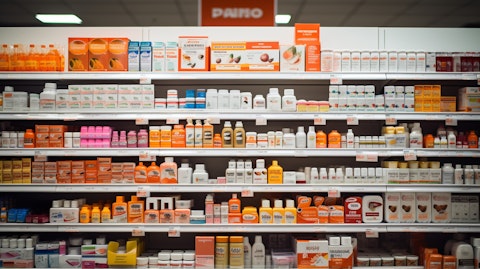Amarin Corporation plc (NASDAQ:AMRN) Q2 2025 Earnings Call Transcript July 30, 2025
Amarin Corporation plc beats earnings expectations. Reported EPS is $-0.03, expectations were $-0.66.
Operator: Good morning, and welcome to Amarin Corporation’s Conference Call to discuss its Second Quarter 2025 Financial Results. I would now like to turn the conference over to Mr. Mark Marmur, Vice President, Corporate Communications and Investor Relations at Amarin. Sir, the floor is yours.
Mark Marmur: Good morning, everyone, and thank you for joining us. Please be aware that this conference call will contain forward-looking statements that are intended to be covered under the safe harbor provided under federal securities law. We may not achieve our goals, carry out our plans or intentions or meet the expectations disclosed in our forward-looking statements. Actual results or events could differ materially, so you should not place undue reliance on these statements. We assume no obligation to update these statements as circumstances change. Our forward-looking statements do not reflect the potential impact of significant transactions we may enter into, such as mergers, acquisitions, dispositions, joint ventures or any material agreements that we may enter into, amend or terminate.
For additional information concerning the risk factors that could cause actual results to differ materially, please see the Risk Factors section of our annual report on Form 10-K for the year ended December 31, 2024, and the quarterly report on Form 10-Q for the quarter ended June 30, 2025, which have been filed with the SEC and are available through the Investor Relations section of our website at www.amarincorp.com. We encourage everyone to read these documents. An archive of this call will be posted on Amarin’s website in the Investor Relations section. Turning to today’s agenda. Aaron Berg, Amarin’s President and Chief Executive Officer, will provide an update on the state of our business and operational progress; and Pete Fishman, Amarin’s Chief Financial Officer, will review our second quarter 2025 financial results.
Following these prepared comments, there will be a question-and-answer session. With that, I will turn the call over to Aaron Berg, President and Chief Executive Officer of Amarin. Aaron?
Aaron D. Berg: Thank you, Mark. Good morning, everyone, and thank you for joining us today. Q2 2025 was a pivotal quarter for Amarin, marked by decisive strategic actions and steady operational progress. Two significant strategic actions marked a pivotal shift for the company. First, we entered into a long-term licensing and supply agreement with Recordati, intended to accelerate commercialization for VAZKEPA across Europe. Partnering with Recordati will build on our early efforts to drive the commercialization of VAZKEPA in this important growth market. Our core franchise will now be in the hands of a partner with significant cardiovascular experience, established infrastructure and the resources to build on the progress our team has achieved in the region, in particular, related to market access, scientific support and initial commercial launch results.
We expect that through this partnership, VAZKEPA patient penetration in Europe will increase, resulting in benefits for the company and shareholders through the structured royalty stream as well as the sales milestones under the licensing agreement. In conjunction with the European partnership, we further rightsized our global organization, which will result in anticipated operating expense savings of approximately $70 million over the next 12 months. As we continue to operate in an increasingly efficient manner, we’ll focus our resources on contributing to the success of our global partners as they drive growth. Our financial results this quarter reflect the steady operational progress we are making with our business. We delivered solid product sales growth in Europe and other key markets in the rest of the world, both year-over-year and sequentially, while managing our expenses tightly, and we’ve consistently done over recent years.
These significant steps better position us to maximize the global potential for VASCEPA and drive increased shareholder value powered by the following key foundational strengths: Number one, VASCEPA is a proven treatment to reduce cardiovascular risk, supported by robust clinical evidence, including the landmark REDUCE-IT study, which demonstrated a 25% reduction in major adverse cardiovascular events when icosapent ethyl is added to statin therapy. This science is matched with ever-growing support from key opinion leaders, evidenced by endorsement from more than 50 medical societies worldwide due to its proven efficacy and safety profile and the increasing recognition that VASCEPA is a complement to current therapies available today for physicians addressing the cardiovascular risk in their patients.
This recognition by the global scientific community of the significance of the REDUCE-IT data has helped deliver regulatory approvals in 50 countries globally as an effective treatment for cardiovascular risk reduction. Number two, we have a global business with multiple efficient revenue streams across the U.S. as well as the partner markets of Europe and Rest of the World. And number three, we have a strong financial foundation built on a significantly reduced and substantially more efficient operating model, combined with a sound balance sheet of nearly $300 million in cash, 0 debt and on-hand inventory levels sufficient to meet global demand, all of which put us on an accelerated path to positive cash flow. Now regarding operational progress in our second quarter results, we continue to make meaningful progress across our global operations with our enhanced partnering efforts playing a central role in driving growth and expanding access to VASCEPA worldwide.
While the U.S. remains foundational to our business, I’d like to focus on the progress we’re seeing across Europe and in our Rest of World markets, where through our partnerships, we continue to expand access to VASCEPA for patients in need. To start, I’ll talk about Europe. As a result of the tremendous efforts of our team, access and demand for VAZKEPA have been building in the region. During the quarter, in-market demand increased 17% from Q1 2025, a healthy indicator of growing momentum on a sequential basis. Through the first 6 months of this year, in-market demand grew 132% versus the first 6 months of 2024, largely from Spain and the U.K., which continue to drive the majority of uptake and revenue in Europe. In Italy, a key market, our team has been focused on expanding regional access, a critical step to prepare the market for uptake upon launch.
We’ve now secured reimbursement in most local regions, representing over 91% of the total eligible patients, particularly in high-density areas, a positive sign of market interest. As mentioned, our recent partnership with Recordati strengthens our ability to capitalize on this early progress with VAZKEPA and leverages Recordati’s cardiovascular expertise and commercial scale to accelerate utilization in Europe. We are focused on rapidly transitioning the business to Recordati, which we expect to be largely completed by the end of 2025. Both teams are working exceptionally well together, and we’re impressed with how passionate and knowledgeable the Recordati team is about VAZKEPA and its benefits for patients. Now turning to the Rest of the World markets.
Our partners are focused on driving patient uptake through the tremendous value and potential for VASCEPA in their respective markets and continue to make progress in commercialization or regulatory process locally. In China, our partner, EddingPharm, is pursuing their commercialization efforts focused on post-PCI patients in top-tier private hospitals through the self-pay market. This strategy is delivering strong in-market demand growth with 68% growth versus the first quarter of 2025, leading to strong revenue and profitability and is anticipated to meet current internal growth targets. With an estimated 330 million cardiovascular patients and one of the highest CBD mortality rates globally, China continues to represent a significant long-term opportunity for Amarin.
In Australia, our partner, CSL Seqirus is executing a thoughtful launch strategy focused on recent ACS patients. Since January, CSL has seen steady end-market demand growth with 75% growth in the first quarter of 2025 versus the fourth quarter of 2024, the most current period where data is available. This is supported by a strong scientific foundation and a target population of approximately 1.3 million Australians with established cardiovascular disease. In Canada, our partner, HLS Therapeutics, continues to deliver volume growth with 31% month-over-month growth as of May. HLS also recently secured a product listing agreement with Nova Scotia Pharmacare effective July 1, 2025. We expect this will expand public reimbursement and access to VASCEPA across the Canadian market.

Our partner, Biologix, reported strong volume growth across the Middle East and North Africa markets with 62% growth versus the first quarter of 2025, driven primarily by Saudi Arabia. And in Southeast Asia, our partner, Lotus, an established company with significant in-region capabilities, is advancing regulatory and pricing and reimbursement processes across Southeast Asia. Recently, South Korea granted regulatory approval for VASCEPA, taking us to 50 markets globally where VASCEPA has been approved for cardiovascular risk reduction. The product is now progressing through the pricing and reimbursement phase in South Korea, which is expected to take approximately a year. The success of our partners in Europe and Rest of World is critical to our global strategy of making VASCEPA available to the millions of patients in need of cardiovascular risk reduction, including the nearly 8 million patients in Europe with established cardiovascular disease.
All of our partners are demonstrating great capabilities and focus to support the continued expansion of VASCEPA. Lastly, a few comments about the U.S. business, still the core contributor of revenue for the company. We’ve sustained the VASCEPA franchise for more than 4 years after the introduction of the first generic product in the U.S. Thanks to the dedication of our team, we retained all major exclusive accounts through Q2 2025 and our market share remained stable at 43% at quarter end, delivering meaningful revenue and profit contributions that continue to form the foundation of U.S. product sales and margin. As we noted previously and have experienced in prior years, we typically observe prescription volume declines in the first quarter, followed by volume growth in the second quarter.
This was the case for Q2 2025, where we saw volumes increase by 7% sequentially. Looking ahead, while we expect continued year-over-year revenue declines, we remain focused on maximizing value from the U.S. market through smart, efficient and targeted commercial execution. Pricing pressure remains volatile, and it’s still too early to make predictions for 2026. That said, we are prepared to launch our authorized generic when optimal as part of our ongoing product life cycle management approach. In summary, our U.S. business remains a significant cash generator, almost 5 years post-generic entry. The European business and Rest of World partnerships continue to build momentum, and we’re encouraged by the collaborative efforts to ensuring the success of all our partners with the knowledge and support they need to maximize the brand’s global potential.
To conclude, let me end with the following. Amarin today is in a far different and healthier position. We’ve executed a plan to partner out a key growth market, while implementing an even leaner global operating footprint. With these actions, I’m confident that we’re well positioned to deliver value for shareholders. In addition, as mentioned previously, we’re actively working with Barclays as our exclusive financial adviser to evaluate further potential strategic opportunities to capitalize on the inherent value of Amarin and increase shareholder value. There’s no defined time line for this initiative as we’ll take the necessary time to carefully evaluate the best options, and we’ll keep you informed should any material developments arise.
Overall, this phase of the company’s evolution is focused on capitalizing on our strengths financially, operationally, strategically, and we’re poised to efficiently and urgently drive the pace and scope of patient uptake across the key growth markets in Europe and the Rest of World, all driven by an unwavering commitment to our core mission to maximize the global potential of the VASCEPA franchise. With that, I’ll turn it over to Pete Fishman, our Chief Financial Officer, to walk through the financial results for the second quarter. Pete?
Peter L. Fishman: Thank you, Aaron. Turning to the financial results. Q2 2025 total net revenue was $72.7 million, an increase of $5.3 million or 8% versus the prior year period, primarily reflecting the impact of the Recordati upfront payment. Q2 2025 net product revenue was $46.6 million, a 2% decrease, primarily driven by lower net selling price in the U.S., which was almost entirely offset by growth in Europe and in Rest of World markets, an important indication of the potential impact these ex U.S. markets can have on our overall performance as we continue to manage the generic environment in the U.S. As for the U.S. business, Q2 2025 net product revenue was $36.5 million, a decline of 17%, reflecting the continued pricing pressure from generics.
Volumes in the quarter rebounded compared to Q1 as expected, following normal course seasonality and the U.S. team continues to deliver material contributions from this business, despite ongoing and persistent headwinds. In addition, a large national payer moved VASCEPA back to exclusive status as of July 1. We have seen our market share increase to approximately 50% in July, which we believe is likely due to this change. This reflects our continued commitment to compete on price to maintain VASCEPA’s market leadership. Because of pricing dynamics in the market, we do not anticipate that this change will have a material impact on overall profitability. In Europe, Q2 2025 product revenue reached $6.6 million, almost double the prior year period and continuing the trend of quarterly end-market demand growth across all launch markets.
Consistent with recent quarters, Spain and the U.K. continued to be the largest contributors. As commercialization moves to Recordati, we should expect patient access to VASCEPA throughout Europe to expand. We look forward to reporting on this evolving opportunity over subsequent quarters. In Rest of World markets, Q2 2025 product revenue was $3.5 million, significantly higher than the prior year period and driven by partner purchases, indicating that market access for our group partners across this diverse segment is expanding. As a reminder, Rest of World revenue will remain variable quarter-to-quarter based on launch timing, in-market demand and the structure of individual partnership agreements. We remain confident that over time, growth will build across our partnered markets.
Q2 2025 licensing and royalty revenue was $26.1 million, up 31% from the prior year period, clearly reflecting the impact of the upfront payment from Recordati as well as end market demand driven by our partners. Overall, the state of our revenue generation in the quarter indicates momentum in the growth segments of our business, while continuing to realize profitable revenue as we manage the mature U.S. business. Turning to expenses. Let me begin with reminding everyone that in parallel with the Recordati licensing agreement, we initiated a global restructuring where we recognized expenses during Q2 and will continue to incur expenses throughout the rest of the year. This action will result in an estimated $70 million in operating expense savings over the next 12 months, a significant change in our operational footprint and cost structure needed to support the brand globally and run a public company.
Q2 2025 SG&A and R&D were $38.7 million and $4.9 million, respectively, consistent with the prior year period. Our operating expenses continue to reflect our disciplined expense management and do not yet reflect savings from the recently announced restructure. Q2 2025 cost of goods sold was $22.4 million, a decrease of $2.3 million or 9% over the prior year period. Now turning to the balance sheet. We ended the quarter with $298.7 million in cash and investments and no debt. We continue to focus on cash preservation and growth for the future, and the strategic actions we’ve taken will result in significant progress in these efforts. Importantly, our on-hand inventory is sufficient to meet global demand, and we have a robust global supply chain that will enable us to continue to support and supply our partners as market demand grows throughout the world.
In summary, our Q2 2025 results reflect the resiliency in our U.S. business as well as initial indications of growing steady momentum in the still vastly underserved global market outside the U.S. Operationally, we are sufficiently capitalized to finance our operations as we continue to progress on an accelerated path to positive cash flows. And with that, I’ll turn the call back over to Aaron for closing remarks. Aaron?
Aaron D. Berg: Thanks, Pete. In closing, let me finish with the following. We’ve taken steps to better position the company to realize its mission. We monetized the European market after putting in place a substantial base to build off of. VAZKEPA is now in the hands of a proven partner in Europe. By putting in place yet another contributor to our royalty-based revenue foundation, combined with the other partners across the globe, coupled with a significant restructuring and further complemented by our continued maintenance of the mature U.S. market, all of this combines to putting us on a path to eventual growth and positive free cash flow. The timing of realizing these value-creating elements is not yet clear. Rather at a minimum, we’ve taken the right steps to put in place a means by which they can be realized, and we must continue to execute globally.
In short, this is a pivotal time for the company, and we wouldn’t be in this position without the dedication of our employees and partners around the world. So thank you. Your dedication continues to make a meaningful difference in the lives of patients every day. And with that, we’ll get started with Q&A. Operator?
Q&A Session
Follow Amarin Corp Plc (NASDAQ:AMRN)
Follow Amarin Corp Plc (NASDAQ:AMRN)
Receive real-time insider trading and news alerts
Operator: [Operator Instructions] Our first question is coming from Paul Choi with Goldman Sachs.
Paul Choi: My first question is, can you maybe just update us on how you’re thinking about your formulary negotiations in the U.S. and potential changes for 2026? Anything that you would call out that we should be mindful of it, as we sort of think about how your U.S. trajectory might look like and the role of potential authorized generic and how that figures in your ’26 strategy? And my second question is, now with the Recordati partnership signed, can you maybe just share with us what sort of metrics you’re going to provide to the Street, so we can just sort of monitor progress and how you plan to benchmark that?
Aaron D. Berg: Thanks, Paul. Appreciate the question. So for the first question around the U.S. business. We’ve continued to maintain our exclusives in 2025. We anticipate that we’ll maintain those exclusives through the rest of 2025. We’ll have further clarity on 2026 as we get toward the end of the year. In terms of the AG, we’ve been prepared and we’ve stated this a number of times, we’ve been prepared to launch an AG when the time is optimal. That time is not yet because we’ve been able to compete very well with the branded product, maintain our volume, maintain the volume profitably in the U.S. And as you know, if you launch an AG, it will further erode the brand. So it’s — right now, it’s in our best interest to continue with the brand.
But we’ll be ready to launch the AG. And that’s based on a number of dynamics in the market. In the IPE market, which is increasingly generic size, more pricing pressure, more competition. We’ll see how that progresses in the future. But here we are almost 5 years since the first generic was introduced into the market. Now there are multiple generics, and we’ve maintained over 40% share in the IPE category. So we’ll continue to execute on the U.S. business with this strategy, which has worked well. Regarding Recordati, overall, we’re in the transition phase right now. The teams are working exceptionally well together. There are a lot of moving parts. Essentially, it’s — our team has been doing a lot of work. There’s a lot of activity, a lot of progress made in individual countries, and we’re trying to smoothly and quickly pass the baton to Recordati.
They’re excited to pick it up. They’re going to make the product a priority. And we’ll have, as we stated in the script, that Recordati will have full controlled commercialization by the end of the year. We’ll have further clarity on end-market demand as time goes on. As you know, with launches, which some of this is, particularly in Italy, it takes some time for commercialization efforts to make an impact. But once we see that impact, we’ll certainly be commenting on end market demand in Europe, and we’ll certainly be providing the financial results as we have on a quarterly basis. Thank you. Hope that help.
Operator: Our next question is coming from Jessica Fye with JPMorgan.
Jessica Macomber Fye: Curious with the rebound in script growth quarter-over-quarter, just kind of how you’re thinking about U.S. volume for the back half of the year as well as kind of your latest expectations on the near-term trajectory for net price in the U.S.? And then separately, you mentioned kind of you’re reviewing other strategic opportunities. What’s on the menu there? I mean not committing to anything, but just kind of like what are some of the possibilities that you might entertain? And then lastly, just a little help with modeling. Can you just help us think about kind of like the time frame over which we should expect that $70 million of annualized cost savings to be realized with a little more nuance kind of quarter-by-quarter?
Aaron D. Berg: Sure. Jess, and thanks for joining us, and thanks for the — for the questions. First of all, regarding the volume in the U.S. in the second half of the year, not only do we maintain the exclusives that we had in the first half of the year, but a major payer put VASCEPA back in the exclusive position for the — starting July 1. And that’s why you saw — I assume you’re commenting on that rebound in our share and our volume. There’s a typical Q2 growth and then we had a payer add VASCEPA to the exclusive position in Q3. So we expect to maintain that volume going into the second half of the year. And as we stated, we’ll have further clarity on 2026 as we get to the end of the year. Pete, do you want to comment on net price?
Peter L. Fishman: Sure. Thanks, Aaron, and thanks for the question. As far as net price, we would expect it to remain fairly comparable to what we’ve seen in Q2 as long as we don’t lose any of the exclusives for the rest of the year. As Aaron had mentioned, we don’t anticipate losing them, but that would be where we would see an impact on net selling price. Otherwise, the way you can look at it is relatively consistent to this next quarter. Also, I’ll go through from the cost savings and the $70 million. The way we would look at it is you could really kind of straight line that over the next 4 quarters — in that this next quarter, so as we’re going through the transition period, you may not see the similar, there may be a little bit less of that savings as — but you see that kind of in the restructuring bucket in terms of that cost amount. But from an OpEx, excluding restructuring, you’ll begin to see that kind of on a straight-line basis over the next 4 quarters.
Aaron D. Berg: Then regarding the question around the strategic opportunities. So right now, our primary focus is on driving VASCEPA globally, helping all of our partners, in particular, of course, a major focus on Europe right now to help Recordati get up to speed and take command of the commercialization efforts as quickly as possible. And we’re looking forward to them making an impact and doing what we can to help them make an impact through the rest of the year, and certainly kicking off 2026. But with regard to the strategic opportunities, we’re in a position of strength. We’ve got a solid operational and financial foundation. It’s — we’ve just made it much stronger as a result of this partnership and the restructuring and the resulting cost savings.
Nothing is off the table in terms of those options. We’ll be very judicious in looking at what those opportunities are. They can take any shape or form. Of course, there’s no assurance or time line for the transaction and no assurance that a transaction will occur. And overall, we don’t intend to comment further or provide updates with respect to strategic alternatives other than what’s required of us. But we look forward to approaching this effort with enormous confidence from a position of strength and a focus on shareholder value. Thank you.
Operator: Our next question is coming from Roanna Ruiz with Leerink.
Unidentified Analyst: This is [ Mehdi Mohammad Ali ], on for Roanna Ruiz. One, it’s a 2-parter, but one from us. So with strong IP protection in Europe and Recordati’s established CV infrastructure, what are your realistic expectations for European market penetration over the next 3 to 5 years? And then kind of a second part to this is, how does Recordati’s presence in both primary care and specialty cardiology position VAZKEPA differently than your previous direct approach?
Aaron D. Berg: Thanks, Mehdi. So first of all, as we’ve commented before, it’s very early to be making projections on 3 to 5 years of what we expect from a forecasting perspective out of our partnership in Europe. We know we’re at the early stages in a number of countries. We know that our team has done a phenomenal job with what we’ve had. It’s been a limited effort, all hands-on deck with who we’ve had, but we’re a smaller organization as we’ve commented on before. We were trying to build from scratch. We had no existing infrastructure. We had to build that. The relationships, establish the brand, all of that we had to do. Recordati, on the other hand, is a well-established cardiovascular European organization, and we’re thrilled to see their passion and how quickly they want to take command and be driving growth.
So we’re very optimistic about the ability to grow and the ability to accelerate the growth. Around — part of that is part 2 of your question. And that is our efforts have been very focused on the highest risk patients and focused on specialists. We’ve been more — operating more as a specialty organization in Europe, very limited in terms of our infrastructure, in terms of our spend, in terms of our reach to providers. Recordati, they see the opportunity and because of the label and the reimbursement we have, which is broad, they have the opportunity to go to the physicians that treat these patients, which include primary care as well. Given that they have an already established primary care organization on top of a cardiology-centric organization that will make this certainly much better, make the impact, we think, much greater than we would have been able to do.
So we look forward to that growth. And when the time is right, once they make an impact, as we said earlier, we’ll be reporting on what those results are.
Operator: Thank you. As we have no further questions on the lines at this time, I would like to hand the call back over to Mr. Berg for any closing remarks.
Aaron D. Berg: Yes. Thank you very much. I appreciate it. And first of all, we hope everyone found the update helpful. We appreciate you taking the time out of your busy days to join us today, and enjoy the rest of the day. Thank you.
Operator: Thank you, ladies and gentlemen. This does conclude today’s call. You may disconnect your lines at this time, and we thank you for your participation.
Follow Amarin Corp Plc (NASDAQ:AMRN)
Follow Amarin Corp Plc (NASDAQ:AMRN)
Receive real-time insider trading and news alerts





